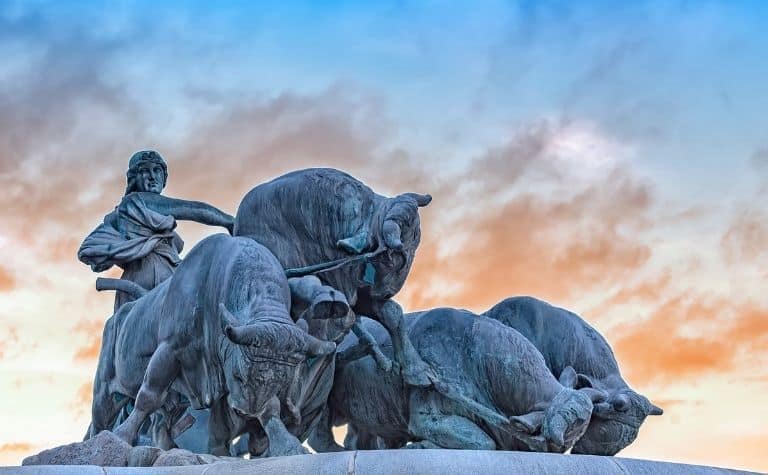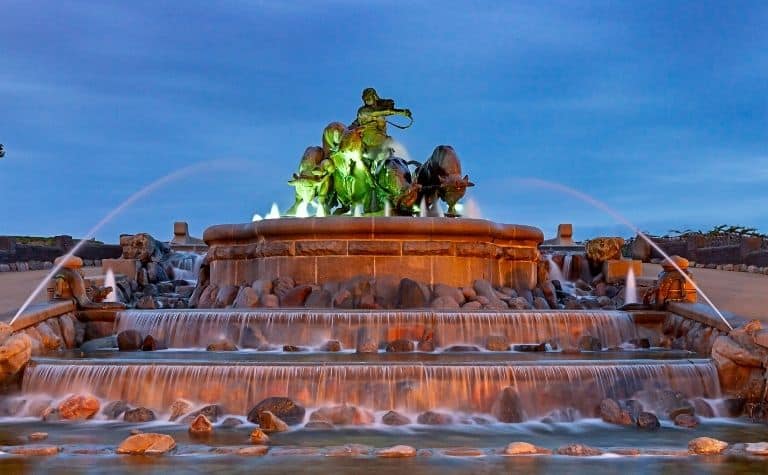In Norse mythology, gods like Thor may steal all the thunder (no pun intended) but not to be outdone, the Asynjur (as the goddesses in the Norse pantheon of deities are collectively known) count among their ranks a master practitioner of shamanism, the ruler of the high seas, and overseer of a major realm in the afterlife.
10 prominent goddess in Norse mythology are: Freyja, Frigg, Skadi, Sif, Jord, Ran, Idun, Saga, Eir, and Hel. Freyja is the most well-known goddess in Norse mythology and in many ways rivals Odin in power.
Norse goddesses are a formidable crew with powers that rival their male counterparts. Here is a look at 10 goddesses in Norse mythology that you need to know.

Freyja
The list of prominent Norse goddesses fittingly begins with Freyja, whose domain includes such matters as love (and lust), fertility, marriage, and even material wealth.
But her high stature as a deity can be attributed to her two most formidable powers:
- Mastery of the mysterious art of seidr, which includes the power to alter the future, bestow good fortune, and lay curses
- Selection of fallen Viking warriors to join her in the afterlife in Folkvangr, reputedly with the first choice before Odin and his Valkyries for Valhalla [1]
By nearly all accounts, Freyja is the most powerful and deeply revered of all Norse goddesses. In some respects, namely sorcery and overseer of Vikings killed in battle, her powers are on par with those of Odin.
Also, see the full article: Freya: Goddess of Love, Witchcraft, and War
Frigg
As the wife of the all-father Odin and mother to Baldur, one of the most beloved of all Norse gods, Frigg keeps company with Norse mythology’s elite figures.
She is the equivalent of royalty among Norse deities, as the incontrovertible queen of the Aesirs. [2]
It is believed that the day of the week Friday derives from an Old English term meaning “Frigg’s Day.”
Frigg is associated with important aspects of the lives of ancient Norse people, including such matters as:
- Fertility
- Love and sexuality
- Marriage
- Prophecy
- Wisdom
There is a significant overlap between the attributes of Frigg and those of Freyja, and there is a scholarly argument that the two entities are, in fact, the same goddess. (Also see Did Female Viking Warriors Go to Valhalla?)

Skadi
Nicknamed the “snowshoe goddess,” Skadi (also spelled Skaldi) may be one of the most hot-tempered and fearless of the deities on this list. [3]
Although she is often associated with the Aesir gods, this is only by virtue of her marriage (more on this later) to the god of the sea, Njord.
By birth, Skaldi is a giantess, a member of the Jotnar (race of giants), the eternal adversaries of the Aesir and Vanir gods.
Skaldi’s father, Thiazi, kidnapped the goddess Idun and was subsequently killed by Odin during Idunn’s rescue.
Armed to the teeth, Skaldi vowed to avenge her father’s death and threatened to take on all of the gods of Asgard by herself. (Also see Why Did the Vikings Worship Odin?)
To appease the grief-stricken giantess, the Aesirs promised to allow Skaldi to select one of their own to be her husband – but only by looking at their feet to make her choice.
Sadly for Skaldi, the handsome feet she chose belonged not to Baldur, whom she had hoped to select, but to Njord, god of the sea.
By some accounts, this union lasted less than a month, but for her bravery and feistiness, she has remained a popular goddess in the eyes of the Norse people. (Also see The Giants of Norse Mythology)
As befitting a popular deity among ancient Scandinavians, Skaldi not only oversees matters relating to hunting and winter, she is perhaps most famously viewed as the goddess of skiing.
Sif
The legacy of the goddess Sif is eclipsed by her rock star husband Thor, the god of thunder and easily the most popular and widely worshipped of all Norse deities. [4]
She is a goddess with great prestige in her own right and is best known as the overseer of:
- Family
- Fertility
- Wheat, which was a vital crop to the ancient Scandinavians
But Sif may be best known for her long, flowing, golden locks which are surely the envy of all Asgard.
In fact, Sif’s hairdo played a central role in her husband attaining his signature weapon, Mjolnir the hammer, thanks largely to the mischief of Loki. (Also see Who Can Lift Thor’s Hammer?)
As a prank, Loki cut off Sif’s hair leaving her nearly bald. Upon seeing his distraught wife without her golden locks, Thor flew into a rage, sparing Loki’s life only on the promise that he would make amends.
Through cunning and deceit, Loki not only secured a magical wig to restore Sif’s golden locks, but he also managed to trick master metal-smith dwarves into fashioning the enchanted hammer that would become Mjolnir. (Also see Meet the Dwarves of Norse Mythology)
Jord
Jord is a goddess (and by some accounts also a giantess) whose main claim to fame is being the birth mother of the most popular of all Norse gods, Thor.
This distinction alone places her in distinguished company, but some scholars suggest that it is what Jord represents rather than who she actually is, which is the most significant aspect of her role in Norse mythology.
The name Jord means “earth,” and it is believed that the symbolism of Thor being born of the earth (with the help of his father Odin, of course) is more important than the actual identity of his biological mother. [5]
The fact that Jord hardly appears in any stories or legends would seem to bear this out. (Also see Do Norse Pagans Pray to Norse Gods and Goddesses?)
Ran
The most famous of the Norse people, the Vikings, were known as fearless seafarers who not only took to their iconic longships to conduct their bloody raids but also to establish distant trade routes and explore new lands to settle.
As such, they were particularly wary of long journeys over often-treacherous waters of the Northern Atlantic.
Ran is the goddess of the sea who lives far below the surface with her husband Aegir (he is a giant by birth, but the couple has always been on friendly terms with the Aesir gods). [6]
Together, they rule the oceans with their nine daughters, each of whom is named after a particular type of wave, such as:
- Kolga – cold wave
- Hefring – lifting wave
- Himinglaeva – transparent wave
According to Norse myths, Ran would wait below the surface of the ocean with her enormous fishing net, waiting for unsuspecting vessels to sail past.
At an opportune moment, Ran would cast her net, ensnaring entire ships and their crew, and drag the sailors down to their watery graves, where they would presumably spend the afterlife with her.
So concerned with the prospect of perishing by the whims of Ran were the Vikings that they were known to perform special rites in her honor prior to embarking on their journeys in the hopes that she would spare their lives and allow them to return home safely. (Also see Did the Vikings Ever Reach America?)
Idun
Known in Norse mythology as the “maiden of the gods,” the goddess Idun is the keeper of enchanted golden apples that are the source of eternal youthfulness for the gods who consume them. [7]
She also plays a key role in the mythological tale of the goddess Skadi for it is Idun who is kidnapped by Skadi’s father, and therefore indirectly tied to his death at the hands of Odin and the other Aesir gods.
In addition to eternal youth, Idun is associated with:
- Eroticism
- Sexuality
- Reproduction
While not as famous or revered as her fellow goddesses, Idun is nevertheless a familiar name in Norse mythology, thanks to her magical apples.
Saga
Although lesser known than her fellow goddesses, Saga is, by some scholarly accounts, a prominent figure in Norse mythology who ranks among the most important Asynjur, as evidenced by her chummy relationship with the all-father Odin.
Old Norse poems depict Saga and Odin sitting beneath the ocean’s surface, imbibing cheerfully in each other’s company. [8] (Also see This Is Why Odin Lost His Eye)
Saga is a seeress and closely associated with wisdom and poetry, which can certainly explain her kinship with Odin. There are even those that suggest that Saga and Odin’s wife Frigg are one and the same.
Eir
Widely known as the Norse goddess of healing, Eir is referred to by some sources as a member of the Aesir clan and by others as a Valkyrie. [9]
In either case, she is a prominent figure in Norse mythology, particularly with regard to warfare, as Eir selects those warriors who will survive battles and recover from their wounds.
In this regard, her responsibilities are surely most significant to warriors and the like.
That Eir is the healing goddess of Norse mythology is indicative of the times in which ancient Scandinavians lived, as healing arts back then were practiced almost exclusively by women.
Hel
As the overseer of the underworld destination of the same name, Hel is a goddess frequently associated with death and the afterlife. [10]
Hel may be more accurately characterized as a giantess, as her father Loki and mother Angrboda are both giants. Her siblings are well known to those familiar with the Ragnarok narrative:
- Jormungandr the colossal serpent who is slain by Thor but whose venom also kills the Norse god
- Fenrir, the great wolf who devours Odin and his army of einherjar
Despite being phonetically identical to hell, the Christian afterlife destination, Hel is not a place of eternal damnation.
Norse mythology does not assign post-death destinations as rewards or punishments for certain types of behavior in life.
Nevertheless, Hel is a dark, grim, and by most accounts, a fearsome figure whose dominion over the realm of Helheim makes her a goddess in Norse mythology that you need to know.
Conclusion
The goddesses that make up the Asynjur are a diverse group of female deities whose importance to Norse mythology is profound and irrefutable.
References:
[1] Source
[2] Source
[3] Source
[4] Source
[5] Source
[6] Source
[7] Source
[8] Source
[9] Source
[10] Source
